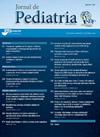An analysis of the remission phase in type 1 diabetes within a multiethnic Brazilian sample
IF 2.5
4区 医学
Q1 PEDIATRICS
引用次数: 0
Abstract
Objective
To assess the frequency and potential influencing factors of the remission phase (RP) in Type 1 Diabetes (T1D) as well as the associations between various criteria used for its definition.
Methods
This was a retrospective cohort study based on data collected from medical records. Three criteria were used to evaluate RP: (1) Glycated hemoglobin (HbA1c) < 7.5 % with an insulin dose < 0.5 U/Kg/day, (2) HbA1c < 7 % with an insulin dose < 0.5 U/Kg/day, and (3) Insulin Dose Adjusted A1c (IDAA1c) ≤ 9, calculated as IDAA1c = HbA1c (%) + [4 x insulin dose (U/Kg/day)]. Statistical analyses included the Mann-Whitney U Test, Chi-Square Test, and Spearman Correlation.
Results
The sample consisted of 144 T1D patients, with a mean age of 26.22 ± 8.30 years and a mean age of onset of 13.30 ± 8.50 years. Of these, 52.9 % were female, 60.3 % were Caucasoid, and 31 % experienced diabetic ketoacidosis (DKA) at disease onset. One year after diagnosis, the occurrence of RP ranged from 27.2 % to 46.8 %, depending on the criteria used. Three patients experienced RP even after seven years, according to criterion 3. No association was found between RP and age, DKA, or pubertal status at onset. The three RP criteria were highly associated with each other (p < 0.001).
Conclusion
A significant proportion of patients in this sample experienced RP within 12 months of diagnosis. The three criteria for defining RP were strongly associated, indicating their reliability in both clinical and research contexts.
对巴西多种族样本中 1 型糖尿病缓解期的分析。
目的评估 1 型糖尿病(T1D)缓解期(RP)的频率和潜在影响因素,以及用于定义缓解期的各种标准之间的关联:这是一项基于病历数据的回顾性队列研究。评估RP有三个标准:(1) 糖化血红蛋白(HbA1c)< 7.5 %,胰岛素剂量< 0.5 U/Kg/天;(2) HbA1c < 7 %,胰岛素剂量< 0.5 U/Kg/天;(3) 胰岛素剂量调整A1c(IDAA1c)≤ 9,计算公式为IDAA1c = HbA1c (%) + [4 x 胰岛素剂量(U/Kg/天)]。统计分析包括 Mann-Whitney U 检验、Chi-Square 检验和 Spearman Correlation:样本包括 144 名 T1D 患者,平均年龄(26.22±8.30)岁,平均发病年龄(13.30±8.50)岁。其中,52.9%为女性,60.3%为白种人,31%在发病时经历过糖尿病酮症酸中毒(DKA)。确诊一年后,根据所使用的标准,RP 的发生率从 27.2% 到 46.8% 不等。根据标准 3,3 名患者在 7 年后仍出现 RP。未发现 RP 与年龄、DKA 或发病时的青春期状况有关。三种 RP 标准之间的关联度很高(p 结论:RP 与年龄、DKA 或发病时的青春期状况之间没有关联:该样本中有相当一部分患者在确诊后 12 个月内经历了 RP。定义 RP 的三个标准之间关联性很强,这表明它们在临床和研究中都非常可靠。
本文章由计算机程序翻译,如有差异,请以英文原文为准。
求助全文
约1分钟内获得全文
求助全文
来源期刊

Jornal de pediatria
医学-小儿科
CiteScore
5.60
自引率
3.00%
发文量
93
审稿时长
43 days
期刊介绍:
Jornal de Pediatria is a bimonthly publication of the Brazilian Society of Pediatrics (Sociedade Brasileira de Pediatria, SBP). It has been published without interruption since 1934. Jornal de Pediatria publishes original articles and review articles covering various areas in the field of pediatrics. By publishing relevant scientific contributions, Jornal de Pediatria aims at improving the standards of pediatrics and of the healthcare provided for children and adolescents in general, as well to foster debate about health.
 求助内容:
求助内容: 应助结果提醒方式:
应助结果提醒方式:


